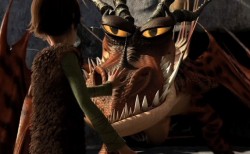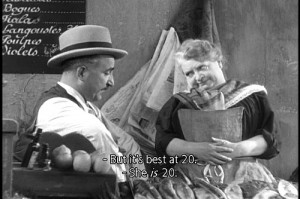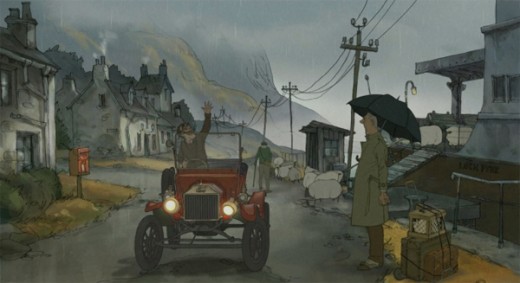Animation &Articles on Animation &Commentary 06 May 2010 07:21 am
Dragons & Fanny
 - For the past few weeks, Michael Barrier’s review of How to Train Your Dragon has been on my mind. Actually, not most of the review, just the last two paragraphs. Most of the review talks about the Dreamworks film, and, I must say, it doesn’t encourage me to see it (which I eventually will most certainly do – once they screen it in 2D in New York).
- For the past few weeks, Michael Barrier’s review of How to Train Your Dragon has been on my mind. Actually, not most of the review, just the last two paragraphs. Most of the review talks about the Dreamworks film, and, I must say, it doesn’t encourage me to see it (which I eventually will most certainly do – once they screen it in 2D in New York).
I haven’t yet seen it , but the film, from the ads I’ve seen, looks like the generic Dreamworks product. All of the characters are supposed to be Vikings living in the First Century, but they act and sound like generic animated characters in the 21st Century. It’s just about a given for such current product. The stock facial expressions, the overarching eyebrows, the attitude. In all of the ads and clips I’ve seen, America Ferrara screams every one of her lines. That’s what poses for acting today in most animated films – a direct influence of TV.
Perhaps I’m wrong, but I somehow doubt it. I’ll find out for myself when I do see it. (After all I put down Kung Fu Panda, and I now think pretty highly of that film.) Regardless, this isn’t the part of the commentary that Mike’s written that has my thoughts rambling about.
 He jumps in his review to Marcel Pagnol’s Fanny Trilogy. Seeing these three films is perhaps one of my all time favorite movie experiences. They played in NY in the 70’s on three consecutive Mondays. I got so hooked into it, I looked forward enormously to those Monday showings. Mike describes them beautifully. All character development and a simple straightforward story that just about breaks your heart. It’s a wonderful film experience despite the fact that it’s a crusty old 1930’s film with lots of soft grays and soft focus. They’re obviously sets built around the Marseilles they’re pretending to create, but you buy it all. At least I did; it’s so wonderfully Romantic.
He jumps in his review to Marcel Pagnol’s Fanny Trilogy. Seeing these three films is perhaps one of my all time favorite movie experiences. They played in NY in the 70’s on three consecutive Mondays. I got so hooked into it, I looked forward enormously to those Monday showings. Mike describes them beautifully. All character development and a simple straightforward story that just about breaks your heart. It’s a wonderful film experience despite the fact that it’s a crusty old 1930’s film with lots of soft grays and soft focus. They’re obviously sets built around the Marseilles they’re pretending to create, but you buy it all. At least I did; it’s so wonderfully Romantic.
(Perhaps, that’s a generational thing. I talked an intern in my studio into watching Citizen Kane, and she couldn’t get through it. The B&W was too distracting for her, and she found the film boring. What can you say?)
Mike Barrier rightfully makes the leap to Snow White and the Seven Dwarfs, a natural link – animation wise – to Pagnol’s trilogy. The approach is very similar. Somehow I’d never have seen the link to these films, but it works. Despite the enormous difference in story, the dependence on character development and motivation are alike. A sweet, simple, direct story with very strong character personality holds you tightly throughout.
A lot of this approach stayed with the Disney features right through Sleeping Beauty. I love the first 10 or 15 minutes of all those films; nothing but character setup, and they’re all wonderful. Things started to change with 101 Dalmatians and had been just about abandoned by the time they got to The Aristocats. Character suddenly became reliant on celebrity voices. Thanks to the star turns such as Phil Harris’ Baloo the Bear in Jungle Book, it became easier for animators to pull their characters together. Let the voices do the heavywork, and in The Aristocrats, they ran with it to the film’s detriment.
Now we get unidentifiable celebrities, like America Ferrara, shouting their lines but adding nothing to the character’s personality. I’m not even sure if her name will help sell a DVD. Given these flat voices, the animators turn to their stock poses and facial expressions, and the end result is a sad lot.
I’d like to think that Chris Sanders and Dean DeBlois have surpassed the Dreamworks formula and taken their film to another level. I have been a big fan of Lilo and Stitch, although I think much of the story is hackneyed nonsense. (Whenever we have to see aliens fighting from their spaceship, it’s hard to reconcile that with the wonderful character traits between Lilo and Stitch, themselves.) The beautiful artwork choices help carry you through that film. Mike suggests that the end of Dragon may have as big a problem, and he offers to blame that on the executives above Sanders and DeBlois. Perhaps, but Lilo and Stitch had similar problems.
Mike Barrier suggests that that isn’t the entire case with How to Train Your Dragon, and I do hope he’s right. But nothing I’ve seen to date lets me expect it. I do want to be pleasantly surprised, and I’ll let you know if I am.
The film I’m really waiting to see is Sylvan Chomet’s The Illusionist. The story in Triplettes of Belleville fell apart, but the execution and development of the principal personalities was so fine, that the film offered me plenty – and plenty of hope. I do hope and almost expect to see that he has taken this approach to another level. What little I’ve seen leads me to believe I may not be disappointed.


on 06 May 2010 at 7:59 am 1.Elliot Cowan said …
I thought the Dragon film was nearly very, very good.
There are some pedestrian elements that are made all the more frustrating by the fact that the rest is so enjoyable.
on 06 May 2010 at 12:29 pm 2.Andrea Haid said …
Dragon is a great movie!!! The film was fun and emotional. I loved the relationship between Hiccup and Toothless.
on 06 May 2010 at 1:20 pm 3.Eric Noble said …
I haven’t seen Dragon, but I may wait till it comes out on DVD. Anyway, you have me interested in the Fanny trilogy. I’m always up for seeing a good movie. I enjoy films from the 30s and 40s. I actually saw Citizen Kane just less than a week ago for the very first time. I agree it’s a brilliant film. Orson Welles gives such a masterful performance, along with the rest of the Mercury players. It’s one of those films where it transcends film, and becomes an experience. I live for those kind of films.
Thank you for introducing me to new films Mr. Sporn. I’ll have to get these from Netflix if they’re available.
on 06 May 2010 at 1:22 pm 4.Richard said …
Dragon was a fine kids movie, and while I would admit it’s DW’s best film, need I point out that’s not saying much. I’m anxious to see what the director, Dean DuBlois, does next.
on 06 May 2010 at 1:22 pm 5.Cameron said …
I must admit I’m not entirely certain why Barrier’s ranting so much about the ending to How to Train Your Dragon. It’s very action driven, to be sure, but it was certainly very well directed action that never failed to advance the story.
As to the film itself, I liked it quite a bit, despite a few reservations (some forced humor, a few overly realistic technical components, hit-and-miss voice direction) but, overall, found it to be Dreamworks finest, most honest and riveting work yet.
As to the generational divide, I can’t answer. I’ve not seen the Fanny trilogy (nor do I have any clue why Michael Barrier pulled it out in his review, as great as I’m sure those movies are) but I have no problem with black & white cinematography or old production values despite being a nineteen-year-old “postmodern baby.” What a shame that so many of my fellow students can’t see the beauty in a masterpiece like Citizen Kane. I, for one, think I get more pleasure out of having both Star Wars and The Passion of Joan of Arc in my long list of favorite films.
on 06 May 2010 at 2:31 pm 6.Richard said …
If you thought Citizen Kane was great (and it is), find America’s greatest film director, William Wyler’s film of Lillian Hellman’s play “The Little Foxes.” It’s on DVD.
on 06 May 2010 at 2:33 pm 7.Richard said …
Barrier is a professional crab, with little to offer animation history. His “writing” is amateurish, and so overwhelmingly negative, petty, and speculative as to be unreadable.
I prefer sites like this that CELEBRATE animation/history.
on 06 May 2010 at 3:17 pm 8.Bill said …
TO: Eric,
Have you seen the “Third Man” with Welles? If not, put it on your list, you will not be disappointed.
on 06 May 2010 at 5:17 pm 9.Elliot Cowan said …
Also.
I’ve seen Dragon twice, both in 3D, a feature that I cannot stand.
The second time I watched it in Imax 3D and I have to admit that it made all the difference.
It really did work.
Perhaps it’s the extreme high resolution you get from the Imax that makes it work better, but for whatever reason it did make the experience more exciting (at times).
on 07 May 2010 at 12:04 am 10.Eric Noble said …
“TO: Eric,
Have you seen the “Third Man†with Welles? If not, put it on your list, you will not be disappointed.”
I have not seen that one, but it’s on my Netflix queue. I have seen “The Lady From Shanghai” and enjoyed that very much.
on 07 May 2010 at 7:01 am 11.Pierre said …
I thought Dragon to be very enjoyable, though I think that the original Shrek, as well as Madagascar were their two best.
My biggest complaint about nearly all mainstream films these days (animated and otherwise) is that they are designed to be “event” films. Everything is big, bigger, biggest. All the action is faster and more visceral. And now it’s all in 3D too.
Maybe it’s because I’m now in my late 40′s that I’m drawn to smaller, more intimate films. Perhaps having a family of my own results in a preference for filmic experiencs that I can actually relate to, rather than waking dreams that I can hardly absorb mentally.
on 07 May 2010 at 8:49 am 12.Michael said …
Richard, Michael Barrier is THE preeminent animation historian despite your personal feelings. His accuracy has been 100% on anything he has written. If you don’t like his opinion on films, that has nothing to do with animation history. It’s opinion. I, personally, find anything he says absolutely important. His review of “Dragon” was very positive – though I’m sure I will probably disagree with him in the end, but he’s the only reviewer who can talk about Snow White and the Fanny Trilogy in discussing that Dreamworks film. He got me thinking about the movie and I will keep his review in mind when I see the film.
You have to open your mind up a bit.
on 07 May 2010 at 11:42 pm 13.Cameron said …
I’m all for using examples of older films to back up an argument, but his use of the Fanny trilogy was so broad and disconnected that it felt needlessly pedantic and rather meaningless, except in a trite “intimate films about real human beings are better than big action movies” sort of way. It would have been just as odd if he had made a comparison to something like Tokyo Story.
If he used something with genuine thematic similarity to How to Train Your Dragon, I would have been welcoming of a comparison. Even Bresson’s Au Hasard Balthazar, despite being a decades-old French character film, could have enough of a similarity to invite a comparison, in that it explored a relationship between a young person and an animal unable to speak. Fanny has no real comparable qualities to How to Train Your Dragon, other than Michael Barrier liking that film better.
I do respect Michael Barrier as a historian. But because of things like this, I’ve always found every bit of critical writing he’s done wanting in terms of substance, despite his very opinionated claims. Personally, and you may disagree, I found the worst example of this to be his even more bizarre comparison of WALL-E to Mrs. Miniver. But then I didn’t agree with anything he had to say about WALL-E.
on 08 May 2010 at 9:57 am 14.Pierre said …
Not to derail your discussion, but I recently rented a DVD of an American remake of a Japanese film called Hachi: A Dog’s Tale. It was directed by Lasse Hallstrom (My Life As A Dog and The Cider House Rules) and stars Richard Gere (who produced).
The film is based on the true story of a college professor who’s life is changed by a chance encounter with a dog found at a train station. Every day the dog accompanies his new owner to the train, but one day the master does not return. The dog returns to the train station every day until its own death and how its loyalty to his owner transforms the people around him.
This is a small, intimate film about the relations between a person and their pet and had enormous resonance for anyone having to deal with pain and loss. It’s a bit of a tear jerker to be certain but it’s beautifully done…and there’s not an action sequence in sight! I highly recommend it.
Pierre
on 08 May 2010 at 12:16 pm 15.Michael said …
Pierre: Lasse Hallstrom is an excellent director with a good solid foundation. I’m sure the film is good. May I suggest you see an old Disney film called “Grayfriars Bobby”. The story you described sounds quite similar, although it takes place in Scotland.
Cameron: I actually found Mike Barrier’s reference to to the Fanny Trilogy and Snow White the key to his review of “Dragon”. His use of those films and his mixing them into the conversation had me thinking about his review for weeks after. I can’t say that for any other recent review I’ve read. Sorry it didn’t make an impression on you. I guess I got what he was trying to say.
on 08 May 2010 at 6:44 pm 16.Mario NC said …
I may be biased here, but it annoys me to no end every time I find a reference to an old movie in a review of a newer, more recent movie. I find that attitude as highly condescending to youths. I’m not saying that Barrier or any other animation historians or critics are out-dated. Or that they don’t “get” the products of this decade (CGI, videogames, and so on). I’m 21 and I can enjoy Ozu’s Tokyo Story or an Ingmar Bergman film. In fact, I pretty much prefer Isao Takahata over Miyazaki for the sole reason that his movies are more quiet and contemplative (with Pom Poko as an exception).
I think this perception of the dead of traditional animation (something that I honestly think it’ll never happen) and the “coldness” comes from that generation gap, where older people think that young viewers can’t appreciate the things of the past. It’s this subjective point of view that everything from the internet and the ipod generation is inherently bad and that, for the most part, kids these days are oblivious to real art and only enjoy the “spectacle” (loud and mindless). This is complicated, but I think we have to establish that both things (old and new) coexist in every generation and time. The kids of today will criticize the youths of the future and so on. Every critic must have an open mind to everything (is their job, obviously) and I think that in the Dragon review, Barrier tried to keep an open mind when watching this film. I’m grateful for that. I love Dragon (the last animated feature that resonated so strongly with me was Ratatouille), but I’m still aware that it’s a multimillion dollar product of Dreamworks. Still I can enjoy that product for what it is, a great movie. The predictable and exciting ending (yep, full with explosions, aerial battles and fire) it’s just a part of the fun.
That’s my two cents about this discussion, take it or leave it. And yes, Michael Barrier it still THE animation historian, whether you agree or not with his opinions.
P.D: On the same idea, I’m a full believer that crap is going to be crap in any given time or age, whether it’s a Shirley Temple movie or a live-action Alvin and the Chipmunks sequel.
on 09 May 2010 at 8:09 am 17.Michael said …
Well spoken, Mario NC. There’s nothing I can disagree with you about, especially that Michael Barrier is the foremost critic writing.